
and
The Corwin Ranch

and The Corwin Ranch |

The Corwins called their ranch "El Hoco." The name appears to be Spanish, but there is no such word as "hoco" in the Spanish dictionaries. It very likely is a composite of letters taken from Elmore's full name, ELmore HOward COrwin.
El Hoco became known for its verdant crops. Oats grew to four feet high, and wheat flourished as well. These crops were dry-farmed; that is, they were not irrigated but depended on whatever rain fell that season.
Occasionally items appeared in the newspaper mentioning the ranch's produce; to name a couple of instances, there was an article about the Corwins cultivating the largest squash ever grown in this region, and another story related how they had produced a 52-pound watermelon.
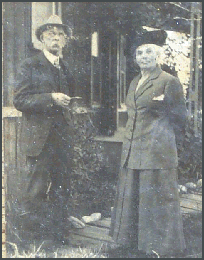
In 1915 Elmore and Harriet went on a weekend camping trip to Deep Creek with Mr. and Mrs. Harry Webster of Hesperia. Nothing unusual in that--Deep Creek was a favorite getaway spot for residents of the upper Mojave Desert region.
What was unusual was that Elmore and Harry Webster's friendship went back at least a half a century; in fact, they had joined the 7th Illinois Cavalry together in 1864. The 16-year-old Corwin, Webster and six others from Canton, Illinois, all joined the unit on the same day. Toward the end of that very year, the outfit became engaged in the Battle of Nashville, and Corwin was severely wounded. It was Webster who carried him from the field.
Elmore was active in the Grand Army of the Republic, the Union veterans' group, and had tried to keep in touch with the members of his unit. He knew that Webster was somewhere around the Los Angeles area, but it came as a complete surprise when he found out that his old Civil War buddy lived only ten miles from his Apple Valley home.
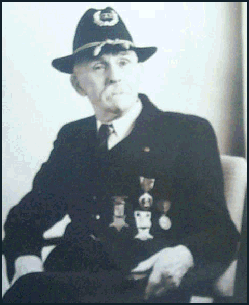
Elmore and Harriet were both very popular members of the community, and the newspaper kept good track of their comings and goings through the years. Over the decades scores of newspaper accounts, some of these probably written by the Corwins, detailed visitors to their Bell Mountain ranch, or their own travels around the country.
The Victor Valley News-Herald ran a column regarding news and events under the heading "Wireless Telephone News From Bell Mountain," and in September 1915 the editor rang up Elmore to get the latest news from El Hoco Ranch:
Editor: Hello, Mr. Corwin, we don't see you
around town very often of late. What are you doing? |
When Elmore said that he had "opened" roads around his ranch, he probably meant he had cleared a path through the brush. His daughter Elma remembers he maintained the roads in the area by means of a drag which he pulled with a team of horses, and he most likely did some original road construction using the same method. Little or no grading would be necessary in the vicinity of the ranch.
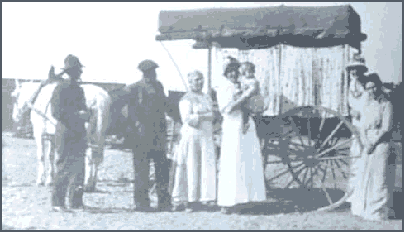
The "wireless telephone" interview is a little gem, giving us the opportunity to hear, in Elmore's own words, the various concerns of running the ranch. Another time, several years later, the editor traveled to the ranch and interviewed Elmore personally. This conversation is informative about El Hoco's crops, which had flourished:
[The editor]
called at the Corwin ranch and was
greeted by Mr. Corwin.... |
Elmore put his chores aside for a big celebration on his 70th birthday, which was June 29, 1917. Those on hand to join in the festivities were his son George, who had moved to Los Angeles, and his daughter Elma, then living in Alhambra. Her children also came to wish their grandfather a happy birthday.
"Mr. Corwin," wrote the newspaper correspondent, "has been a resident of the Bell Mountain district for the past eight years, is one of the substantial and conservative citizens of the valley, and has a host of friends to wish him many happy returns upon his arrival at the age of three score and ten."
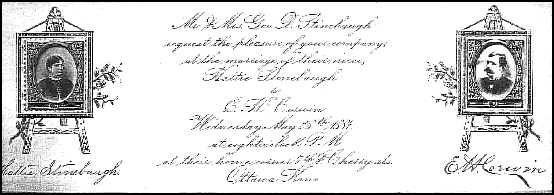
In 1925 El Hoco took on a new atmosphere when Harriet began running a rest home or sanitarium of sorts. She catered to guests at the ranch for the next ten or so years. The Corwins put up a small sign on the main road, today's Highway 18, which said, "Mother Corwin Rest Home 5¾ Mi." After the sign was removed, it was used as a shelf in Elma's home and was discovered accidently by her granddaughter Betty Halbe, who still has it in her possession.
Five small cottages were built on the ranch separate from the house, and ailing guests would convalesce there for periods ranging from a brief few days up to an extended stay of several weeks. These were people with respiratory problems, including tuberculosis. This was just before antibiotics were discovered, and the dry desert air was the primary treatment. Good care and Harriet's home-cooking probably helped, too.
One of the guests who stayed with them was Elroy Waas, who purchased land nearby and became a close friend. Another guest was Allen Smith, the Apple Valley News editor who later stayed at Mother Corwin's ranch in the summer of 1935, when the Waas family was taking care of the place while the Corwins were on an extended vacation. When they returned, the editor struck up a conversation with Elmore, and got an earful on how wonderful Apple Valley was. Smith was one of those amazed at how the old gentleman could still run up and down his windmill tower.

THE MOTHER CORWIN REST HOME SIGN WAS ORIGINALLY PLACED AT WHAT IS NOW HIGHWAY 18. A CONSIDERABLE PIECE ON THE LEFT WAS LATER SAWED OFF TO MAKE IT FIT AS A SHELF BOARD IN THE STINEBAUGH RESIDENCE. THANKS TO THE GRAPHIC WIZARDRY OF RON CARLSON, AN APPLE VALLEY HISTORY BUFF AND PHOTOGRAPHER, WE CAN SEE HOW THE SIGN WOULD HAVE LOOKED IN ITS ENTIRETY. |
The Corwins generally enjoyed good health throughout their years on the desert, with a few bouts of illness, but by 1936 Elmore's eyesight had failed dramatically due to cataracts. Up until this time, in spite of advanced age, they had done well on the ranch, but now they decided to give it up. In February of 1936 they moved into town to live near their daughter Elma, and the following year they sold the ranch to printer and Western artist Kirk Martin.
Four years later Elmore insisted on having cataract surgery, against the advice of his doctors. Complications from the surgery set in, and he passed away at the veterans' hospital in Sawtelle on August 3, 1940, at 93 years of age. Harriet died at her home on May 31, 1950, at the age of 91.
El Hoco has since been divided into several lots with new structures, and nothing remains except the Mother Corwin Rest Home sign, a real artifact of early Apple Valley and a reminder of these two hard-working and upstanding citizens who so dearly loved the valley.





ELMORE CORWIN FELT THE GREGORIAN CALENDAR NEEDED TO BE REVISED. HE COPYRIGHTED THE 8-PAGE PAMPHLET BELOW IN 1937, IN WHICH HE PROPOSES A 13-MONTH CALENDAR, WITH EACH MONTH CONSISTING OF 28 DAYS, BEGINNING ON JANUARY 1, 1939. THE NEW MONTH WAS TO BE NAMED "SUMBER," A WORD COINED BY USING THE FIRST SYLLABLE OF SUMMER AND THE LAST SYLLABLE OF SEPTEMBER, AND THE MONTH WOULD BE PLACED ON THE CALENDAR BETWEEN AUGUST AND SEPTEMBER.
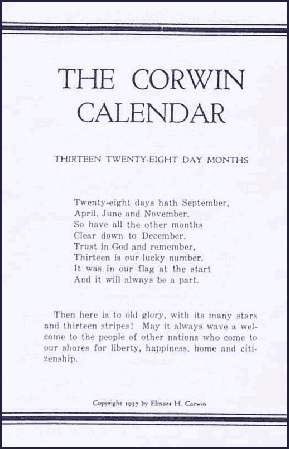

 PAGE
1|
2|
3|
4|
5|
6|
7|
8|
9|
10
PAGE
1|
2|
3|
4|
5|
6|
7|
8|
9|
10

